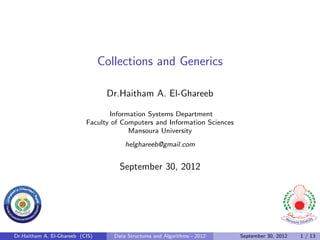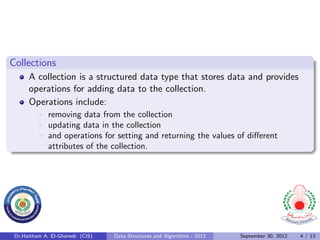Lect02 120929183452-phpapp02
- 1. Collections and Generics Dr.Haitham A. El-Ghareeb Information Systems Department Faculty of Computers and Information Sciences Mansoura University helghareeb@gmail.com September 30, 2012 Dr.Haitham A. El-Ghareeb (CIS) Data Structures and Algorithms - 2012 September 30, 2012 1 / 13
- 2. Good News Received: 23 September 2012 Dr.Haitham A. El-Ghareeb (CIS) Data Structures and Algorithms - 2012 September 30, 2012 2 / 13
- 3. Good News http://www.helghareeb.me/courses/dsa-2012 Dr.Haitham A. El-Ghareeb (CIS) Data Structures and Algorithms - 2012 September 30, 2012 3 / 13
- 4. Collections Dr.Haitham A. El-Ghareeb (CIS) Data Structures and Algorithms - 2012 September 30, 2012 4 / 13
- 5. Collections A collection is a structured data type that stores data and provides operations for adding data to the collection. Dr.Haitham A. El-Ghareeb (CIS) Data Structures and Algorithms - 2012 September 30, 2012 4 / 13
- 6. Collections A collection is a structured data type that stores data and provides operations for adding data to the collection. Operations include: Dr.Haitham A. El-Ghareeb (CIS) Data Structures and Algorithms - 2012 September 30, 2012 4 / 13
- 7. Collections A collection is a structured data type that stores data and provides operations for adding data to the collection. Operations include: removing data from the collection Dr.Haitham A. El-Ghareeb (CIS) Data Structures and Algorithms - 2012 September 30, 2012 4 / 13
- 8. Collections A collection is a structured data type that stores data and provides operations for adding data to the collection. Operations include: removing data from the collection updating data in the collection Dr.Haitham A. El-Ghareeb (CIS) Data Structures and Algorithms - 2012 September 30, 2012 4 / 13
- 9. Collections A collection is a structured data type that stores data and provides operations for adding data to the collection. Operations include: removing data from the collection updating data in the collection and operations for setting and returning the values of di’¼Ćerent attributes of the collection. Dr.Haitham A. El-Ghareeb (CIS) Data Structures and Algorithms - 2012 September 30, 2012 4 / 13
- 10. Collection Types Collections can be broken down into two types: linear and nonlinear. Dr.Haitham A. El-Ghareeb (CIS) Data Structures and Algorithms - 2012 September 30, 2012 5 / 13
- 11. Collection Types Collections can be broken down into two types: linear and nonlinear. A linear collection is a list of elements where one element follows the previous element. Dr.Haitham A. El-Ghareeb (CIS) Data Structures and Algorithms - 2012 September 30, 2012 5 / 13
- 12. Collection Types Collections can be broken down into two types: linear and nonlinear. A linear collection is a list of elements where one element follows the previous element. Elements in a linear collection are normally ordered by position (’¼ürst, second, third, etc.). Dr.Haitham A. El-Ghareeb (CIS) Data Structures and Algorithms - 2012 September 30, 2012 5 / 13
- 13. Collection Types Collections can be broken down into two types: linear and nonlinear. A linear collection is a list of elements where one element follows the previous element. Elements in a linear collection are normally ordered by position (’¼ürst, second, third, etc.). Nonlinear collections hold elements that do not have positional order within the collection. Dr.Haitham A. El-Ghareeb (CIS) Data Structures and Algorithms - 2012 September 30, 2012 5 / 13
- 14. Collection Types Collections can be broken down into two types: linear and nonlinear. A linear collection is a list of elements where one element follows the previous element. Elements in a linear collection are normally ordered by position (’¼ürst, second, third, etc.). Nonlinear collections hold elements that do not have positional order within the collection. An organizational chart is an example of a non- linear collection. Dr.Haitham A. El-Ghareeb (CIS) Data Structures and Algorithms - 2012 September 30, 2012 5 / 13
- 15. Collection Properties and Methods Dr.Haitham A. El-Ghareeb (CIS) Data Structures and Algorithms - 2012 September 30, 2012 6 / 13
- 16. Collection Properties and Methods Collection Property is the collections Count, which holds the number of items in the collection. Dr.Haitham A. El-Ghareeb (CIS) Data Structures and Algorithms - 2012 September 30, 2012 6 / 13
- 17. Collection Properties and Methods Collection Property is the collections Count, which holds the number of items in the collection. Collection operations, called methods, include: Add (for adding a new element to a collection) Insert (for adding a new element to a collection at a speci’¼üed index) Remove (for removing a speci’¼üed element from a collection) Clear (for removing all the elements from a collection) Contains (for determining if a speci’¼üed element is a member of a collection) Dr.Haitham A. El-Ghareeb (CIS) Data Structures and Algorithms - 2012 September 30, 2012 6 / 13
- 18. Linear Collections Dr.Haitham A. El-Ghareeb (CIS) Data Structures and Algorithms - 2012 September 30, 2012 7 / 13
- 19. Linear Collections Direct Access Collections Dr.Haitham A. El-Ghareeb (CIS) Data Structures and Algorithms - 2012 September 30, 2012 7 / 13
- 20. Linear Collections Direct Access Collections Sequential Access Collections Dr.Haitham A. El-Ghareeb (CIS) Data Structures and Algorithms - 2012 September 30, 2012 7 / 13
- 21. Linear Collections Direct Access Collections Sequential Access Collections Generalized Indexed Collections Dr.Haitham A. El-Ghareeb (CIS) Data Structures and Algorithms - 2012 September 30, 2012 7 / 13
- 22. Struct DEMO Dr.Haitham A. El-Ghareeb (CIS) Data Structures and Algorithms - 2012 September 30, 2012 8 / 13
- 23. Non Linear Collections Dr.Haitham A. El-Ghareeb (CIS) Data Structures and Algorithms - 2012 September 30, 2012 9 / 13
- 24. Non Linear Collections Hierarchical Collections Dr.Haitham A. El-Ghareeb (CIS) Data Structures and Algorithms - 2012 September 30, 2012 9 / 13
- 25. Non Linear Collections Hierarchical Collections Group Collections Dr.Haitham A. El-Ghareeb (CIS) Data Structures and Algorithms - 2012 September 30, 2012 9 / 13
- 26. My Collection Class DEMO Dr.Haitham A. El-Ghareeb (CIS) Data Structures and Algorithms - 2012 September 30, 2012 10 / 13
- 27. Generic Programming DEMO Dr.Haitham A. El-Ghareeb (CIS) Data Structures and Algorithms - 2012 September 30, 2012 11 / 13
- 28. Oversimpli’¼üed Timing Tests DEMO Dr.Haitham A. El-Ghareeb (CIS) Data Structures and Algorithms - 2012 September 30, 2012 12 / 13
- 29. Charting in .Net DEMO Dr.Haitham A. El-Ghareeb (CIS) Data Structures and Algorithms - 2012 September 30, 2012 13 / 13





























